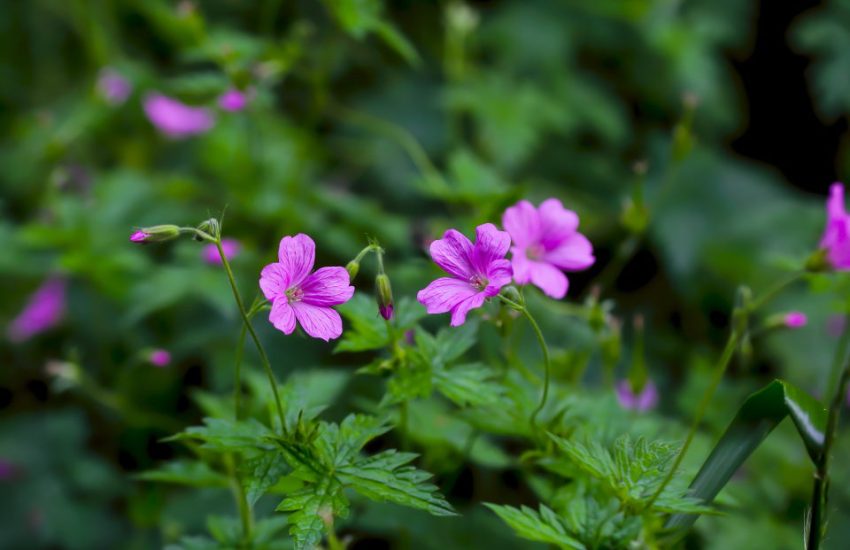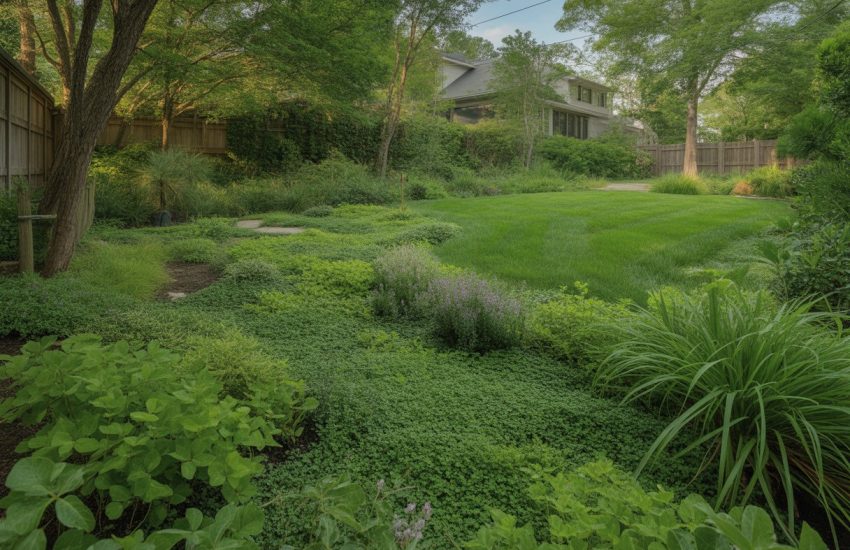Flowering Vines That Will Grow Vigorously in Arizona
Many beautiful flowering vines can be grown in Arizona. Wide varieties of vines thrive in the state’s hot, arid climate, including bougainvillea, morning glories, and Trumpet Creeper. When choosing a vine for your landscape, it is important to consider the plant’s growth habit. It is also important to consider the optimal conditions for the plant to survive. That being said, here are ten vines that can thrive in Arizona.
Bougainvillea (Bougainvillea spectabillis)
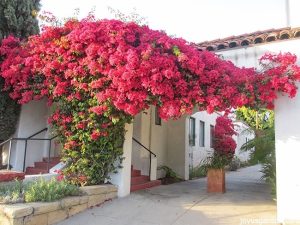
Bougainvillea spectabilis, also known as the great bougainvillea, is a vine-like thorny ornamental plant with colorful papery bracts surrounding small white flowers. Bougainvilleas are named after the French explorer Louis Antoine de Bougainville. These plants can be either deciduous or evergreen, varying in size from vines to shrubs. It is a popular plant in tropical and sub-tropical areas worldwide and can be found in many gardens, parks, and public spaces. The plant is native to South America but has been introduced to other parts of the world, where it has become naturalized in some cases. The plant’s bracts are typically red, purple, or pink but can also be white or orange. Bougainvillea spectabilis is an evergreen plant that can grow to be 10-12 feet tall and 6-8 feet wide. It prefers full sun and well-drained soil and is relatively easy to care for. Once established, it is a drought-tolerant plant that does not require much water or fertilizer. However, it can be susceptible to pests and diseases if not properly cared for. With its vibrant colors and easy care requirements, bougainvillea spectabilis is a popular choice for gardeners looking to add some interest to their landscape.
Cape Honeysuckle (Tecomaria capensis)
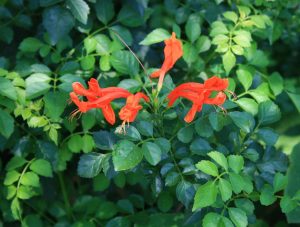
The Cape honeysuckle (Tecomaria capensis) is a densely flowering evergreen shrub that produces a stunning display of orange trumpet-shaped blooms from late fall through spring. Standing 6 to 10 feet tall and wide, this South African native is hardy in USDA zones 9 through 11. The Cape honeysuckle’s arching branches are covered with lance-shaped, dark green leaves that provide year-round interest. But it’s the plant’s prolific flowers that steal the show. Each bloom consists of five fused petals arranged in a trumpet shape. The exterior of the petals is covered in tiny hairs, while the interior is Smooth and glossy. The flowers are borne in clusters at the ends of the stems and attract hummingbirds and bees. Cape honeysuckle is relatively easy to care for, although it does require occasional pruning to control its size and shape. It tolerates most soil types as long as they are well-drained and prefers full sun to partial shade.
The Cape Honeysuckle is well-suited to growing in Arizona, as it is drought-tolerant and can thrive in both full sun and partial shade. To plant the Cape Honeysuckle, find an area of your yard that gets at least six hours of sun per day. Dig a hole twice as wide as the plant’s roots, and mix some compost into the soil before planting. Water the plant regularly, especially during the hot summer, and fertilize it monthly with a balanced fertilizer.
Carolina Jasmine (Gelsemium sempervirens)

Carolina jasmine (Gelsemium sempervirens) is a graceful, evergreen vine with glossy dark green leaves. It produces small, yellow flowers that have a sweet fragrance and bloom in late winter or early spring. Carolina jasmine is native to the southeastern United States and prefers to grow in moist, well-drained soils in full sun to partial shade. It can be difficult to control once it becomes established, so it is often best planted in an area where it can be allowed to roam freely. Carolina jasmine is relatively resistant to pests and diseases, making it a low-maintenance plant for the home landscape. This vine can be guided to climb a trellis or fence, or it can be left to cascade over a wall or down a slope. Carolina jasmine adds year-round interest to any garden with its beautiful flowers and glossy foliage.
Carolina jasmine is a sun-loving plant, so it should be planted in an area that receives full sun. The soil should be well-drained and rich in organic matter. When planting, be sure to leave enough room for the vine to spread. Carolina jasmine can be propagated from seed or cuttings.
Water regularly during the first growing season to help the plant establish a strong root system. After that, only water during periods of extended drought. While it is not particularly susceptible to pests or diseases, it can be bothered by scale insects and mealybugs. These can be controlled with regular applications of horticultural oil.
Cat’s Claw Vine (Macfadyena unguis-cati)
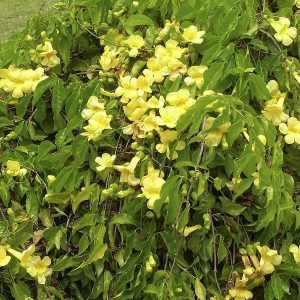
Cat’s Claw Vine (Macfadyena unguis-cati) is a fast-growing, woody vine that can reach up to 30 feet in length. It is a native of Central and South America, commonly used as traditional medicine. The vine gets its name from the sharp, curved thorns resembling a cat’s claws. The thorns are used to help the vine climb trees or other structures. The plant has glossy, green leaves and small, white flower clusters. The flowers are followed by reddish-orange fruits that contain numerous seeds. Cat’s Claw Vine is considered an invasive species in many parts of the world, as it can quickly cover and smother native plants. It is often found in disturbed areas, such as roadsides and clearcuts. The vine can be controlled by cutting it back regularly and removing any rooted sections.
The Cat’s Claw Vine (Macfadyena unguis-cati) is a fast-growing, evergreen vine that is native to the tropical regions of Central and South America. It gets its name from the sharp, curved thorns that line its stems. The Cat’s Claw Vine is a popular plant for use in landscaping because of its ability to quickly cover fences, trellises, and other structures. It can also be used as a ground cover. The Cat’s Claw Vine is relatively easy to grow and can be propagated from stem cuttings or seeds.
To propagate from stem cuttings, take a 6-8 inch cutting from a healthy vine and remove the bottom leaves. Dip the cutting in rooting hormone and plant in a pot filled with a well-draining potting mix. Water regularly to keep the soil moist but not wet. The cutting should root within 4-6 weeks. Once rooted, transplant it into a larger pot or the landscape.
While propagating from seeds, it is important to soak the seed for 24 hours before planting. Plant the seeds in a well-draining potting mix and keep them moist but not wet. Next, place the pot in a warm, sunny location. The seeds should germinate within 2-3 weeks. Once the seedlings are large enough to handle, transplant them into individual pots or the landscape.
Climbing Roses (Rosa species)
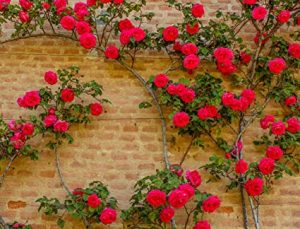
Rosa species, more commonly known as Climbing Roses, are a type of flowering plant in the rose family. Climbing roses are a versatile and popular type of rose, characterized by their long stems and ability to climb or trail along walls, fences, and other structures. There are over 100 species of Climbing Roses, which are native to Europe, Asia, and North America. Climbing Roses are characterized by their long stems and large leaves. They can grow up to 20 feet tall and have a wide range of flower colors, including white, pink, red, and purple. They also have long, sharp thorns that help them cling to surfaces. Climbing roses require regular pruning to keep them healthy and under control. They are also susceptible to several diseases, including blackspot and powdery mildew. With proper care, however, climbing roses can provide years of beauty in any garden. Climbing Roses are popular garden plants and are often used in landscaping.
While they can be grown in a variety of ways, there are a few key considerations that will ensure success. First, Climbing Roses require full sun in order to produce an abundance of blooms. They also need well-drained soil and regular watering, especially during extended heat or drought periods. Additionally, it is important to prune Climbing Roses regularly to promote new growth and prevent the plant from becoming overgrown.
Coral Vine (Queen’s Wreath – Antigonon leptopus)
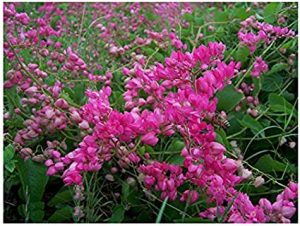
Coral vine is a tropical climbing plant that is native to Mexico and Central America. It is a member of the Buckwheat family, and its scientific name is Antigonon leptopus. The plant has long, thin vines that can reach up to 30 feet in length. The leaves are heart-shaped and have a toothed margin. The flowers are small and white, and they grow in clusters. Coral vine blooms from summer to fall. The plant is not frost-tolerant, so it must be grown in an area that experiences mild winters. Coral vine is a popular choice for landscaping in tropical regions. It can be used as a groundcover or climbing plant and is also often grown in containers. The plant requires little care and can tolerate a wide range of growing conditions. However, it is important to note that coral vine can be invasive in some areas.
Lady Bank’s Rose (Rosa banksiae)
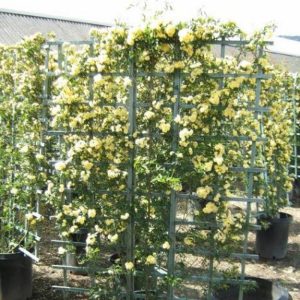
Lady Banks’ Rose is a beautiful and popular climbing rose that is known for its abundant blooms. It is a deciduous plant, meaning that it will lose its leaves in the fall. The leaves are dark green and have a glossy finish. The flowers are double, white, and fragrant, with a diameter of up to 4 inches. They are very fragrant and bloom in the spring and summer. The plant can reach a height of 20 feet and a width of 10 feet, making it an ideal choice for covering large areas. Lady Banks’ Rose is a vigorous grower that is relatively easy to care for. It is drought-tolerant and does not require much pruning. However, it should be protected from strong winds, as the canes are somewhat brittle and can break easily.
Lilac Vine (Hardenbergia violacea)
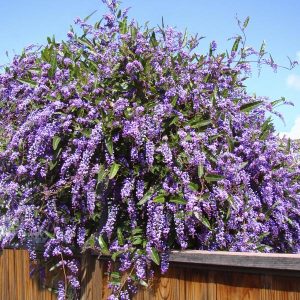
The lilac vine (Hardenbergia violacea) is a stunning plant that is native to Australia. It gets its name from its beautiful Lilac flowers that bloom in the spring and summer. The Lilac vine can grow to be quite large, reaching up to 15 feet in length. This plant is an unusual-looking deciduous climber that has dark green leaves with a purple hue. The leaves are ovate-shaped and have serrated margins. The flowers of the lilac vine are very showy and eye-catching. They are typically a deep violet color but can also be white or pink. The flowers grow in clusters and are followed by black berries. The Lilac vine is a very tough plant that can survive in a wide range of conditions. It is drought tolerant and can even thrive in poor-quality soil. This plant is perfect for gardeners who are looking for something different that will add interest and color to their garden.
Pink Trumpet Vine (Podranea ricasoliana)
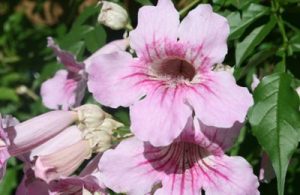
The pink trumpet vine (Podranea ricasoliana) is a fast-growing, evergreen climbing plant. It is native to South Africa, where it is often found growing in rocky terrain. The pink trumpet vine gets its name from its trumpet-shaped flowers, which are usually a deep rose color. Each flower measures about 3 inches wide and has five petals. The leaves of the pink trumpet vine are dark green and glossy, and the stems are covered in small thorns. The plant blooms from late spring to early summer, and the flowers attract bees, hummingbirds, and butterflies. Pink trumpet vines can grow up to 20 feet in length. The pink trumpet vine is a popular ornamental plant and is often grown on trellises or fences. It is also used as a ground cover in some areas. The plant is relatively easy to care for and does not need regular maintenance once established other than pruning.
Potato Vine (Solanum jasminoides)
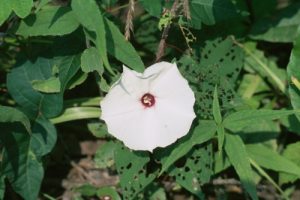
Solanum jasminoides, more commonly known as the potato vine, is a fast-growing, evergreen shrub that produces white, star-shaped flowers. Solanum jasminoides is native to Brazil, but it has been introduced to many other countries and is now widely cultivated as an ornamental plant. The potato vine can reach a height of 30 inches and a width of 10 inches. The leaves are dark green and glossy, and the flowers are borne in clusters of 3-5. The potato vine blooms all year round in tropical climates, but in cooler climates, it will bloom from spring to summer. The potato vine is not frost-tolerant and should be protected from cold weather. Solanum jasminoides is an easy plant to care for and does not require much attention. It is tolerant of most soil types and prefers full sun or partial shade. The potato vine can be propagated from seed or cuttings.

